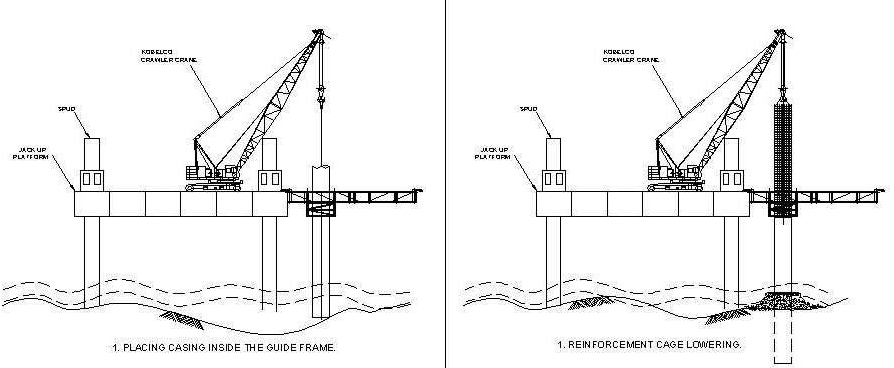 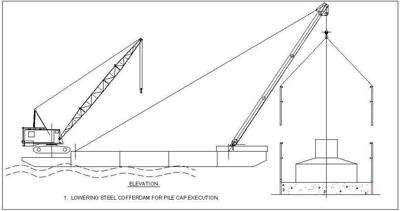 Superstructure The BWSL Project has (9+2) approach bridge modules. These modules range from 3 continuous span units to 8 continuous span units. The deck of the carriageways consists of triple cell precast box girders supported on piers founded on independent substructure. The Concrete Grade for the superstructure is M60. The average weight of the span is 1800 tons, whereas the heaviest span in the bridge (to be erected with the Launching Gantry) weighs 2000 tons. In addition, the trusses were to be designed to receive the segment from the already erected deck as well as from barges parked directly under the truss. Superstructure The BWSL Project has (9+2) approach bridge modules. These modules range from 3 continuous span units to 8 continuous span units. The deck of the carriageways consists of triple cell precast box girders supported on piers founded on independent substructure. The Concrete Grade for the superstructure is M60. The average weight of the span is 1800 tons, whereas the heaviest span in the bridge (to be erected with the Launching Gantry) weighs 2000 tons. In addition, the trusses were to be designed to receive the segment from the already erected deck as well as from barges parked directly under the truss.
The Technical Data for the superstructure is as follows.
Max Longitudinal Gradient = 1.72%
Max Crossfall = 6%
Max Radius in Plan = 600m
Min Radius in Plan = 246m
Typical Span Length = 50m and 30m in Link Bridge
Max Span Weight = 2000 tons
The erection gantry is 1260MT truss designed to erect spans for the above configuration. The unique feature of the truss indeed is the maximum span weight it can handle and that it can launch the pier and EJ segment itself. The truss also has the capacity to align the total span in hanging condition after the gluing is completed. The truss is fully mechanized for self launching and aligning. An individual segment can be aligned on the truss using a set of four hydraulic jacks mounted on each suspension frame. In order to eliminate the casting or erection errors within a span, two wet joints are provided on either end of the span. The wet joints are cast after finalization of the span alignment.
For the fabrication of the truss, the entire structural steel (grade Fe 540) was sourced from within India. The accessories and components however were procured from India and abroad.
A full scale load test was conducted before putting the erection gantry into actual operation.
The erection gantry comprises the following:
a. Main truss
b. Front/rear pylons
c. Front/centre/rear legs
d. Front /rear trolley
e. Cross beams
f. Stressing gondola
g. Suspension frames
h. Connection beams-Type A/B
i. Spreader beams- Type A/B
j. Pier bracket
k. Chain Support
A Typical 50m span of the approach bridges comprises 15 field segments, a Pier segment and 200mm (nominal) in-situ wet joints. During the span construction, all field segments are suspended from the Gantry, glued and temporarily stressed together. Once the gluing
operation is completed, span alignment to the Piers is followed. After alignment, the wet joints are cast including grouting of bearings top plinth. Once the wet joints achieve the required strength, stressing of longitudinal PT is commenced followed by load transfer of Span to Piers. 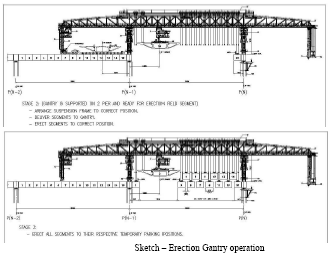 Relocation of Launching Trusses using 1600MT capacity Barge Mounted Crane – Asian Hercules After the successful erection of the deck on Bandra side, the trusses were required to be shifted across the Bandra cable stay bridge by 600 meters to Worli side to take up the spans Relocation of Launching Trusses using 1600MT capacity Barge Mounted Crane – Asian Hercules After the successful erection of the deck on Bandra side, the trusses were required to be shifted across the Bandra cable stay bridge by 600 meters to Worli side to take up the spans
beyond the Bandra Cable Stay.
Various options like (i) dismantling of the trusses at present locations and reassembling them at new locations, (ii) lowering the trusses on a suitable floating craft and shifting and erecting them, and (iii) shifting the total truss using a floating crane, etc were analyzed in detail.
Taking into consideration various constraints like limited working period available to execute the work in sea, the effect of open sea on dismantling and re-erection, etc, the best option available was the relocation of the trusses in one piece using a floating crane.
Asian Hercules is one of the biggest floating shear leg cranes in the world. This crane is mounted on a barge which is over 240 feet long and more than 130 feet wide, weighs 5,900 tons and has enough lifting capacity (1600 MT) to lift a weight equal to 2,000 small cars. It
started its voyage from Singapore on October 9, 2006, and arrived at Mumbai’s shores on October 27, 2006. After obtaining the necessary regulatory clearances, it commenced operations from November 06, 2006, including trial runs and realignments in its settings.
Selection of equipment was done considering various challenges, like the draft and space available at working locations, tide limitations, and other weather constraints.
The process: The biggest hurdle on the Asian Hercules operation was that the draft at the required locations was not good enough to carry out the operation smoothly without disturbing the VSNL cable lying underneath. This problem was overcome by using sophisticated global positioning system and carrying out the entire operation in a series of
smaller operations during the favourable high-tide. First the Asian Hercules Crane was positioned at the required lifting position. A complex operation of balancing the vessel using ballasting was carried out as per the predetermined stages. Positioning of the vessel was done considering the draft requirements. A specially fabricated lifting spreader was fixed to the truss to facilitate the lifting.
The truss load was taken by the crane in stages so that the lifting operation was smooth.
Through computerized central monitoring, the load in individual lifting points was monitored to ensure that no point was overloaded.
After taking the load, the Asian Hercules crane was moved to a safe location where enough water depth (draft) was available to park the crane with the truss. Then the crane with the truss was moved to a new location during the next high tide. The truss was then lowered on to
the final location. The lowering of truss at the final location was achieved through Guides, which helped to achieve a final placement accuracy of ±50mm. The operation, which otherwise would have taken one complete year, was completed in matters of a few days. Cable Stay bridges It is for the first time that cable stay bridges have been attempted on open seas in India. 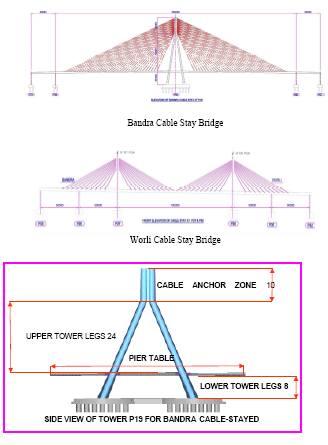 Coupled with the fact that the aesthetically designed pylons have an extremely complex geometry and one of the longest spans for concrete deck, the challenges encountered were indeed formidable. Coupled with the fact that the aesthetically designed pylons have an extremely complex geometry and one of the longest spans for concrete deck, the challenges encountered were indeed formidable.
Construction of Pylon Tower Legs
The salient characteristics of the pylon tower that make it complex and challenging from the point of view of constructability are as follows:
(a) The section decreases gradually with height;
(b) There are horizontal grooves at every 3m height and vertical grooves for circular portion that requires special form liners as well as it requires attention for deshuttering;
PIER TABLE
CABLE ANCHOR ZONE 10
LIFTS
UPPER TOWER LEGS 24
LIFTS
LOWER TOWER LEGS 8
LIFTS
SIDE VIEW OF TOWER P19 FOR BANDRA CABLE-STAYED
BRIDGE
(c) The tower legs are inclined in two directions, which creates complexities in alignment and climbing of soldiers;
(d) Construction joints permitted only at 3m level. Inserts were permitted only in horizontal grooves provided at 3m height.
On not being able to get immediate solution from reputed worldwide formwork manufacturers, the project design team designed an automatic climbing shutter formwork system, which was fabricated on site and employed to execute all tower leg lifts below deck level. To affect further reduction in time cycles, HCC approached Doka, Austria. Doka then devised a customized solution based on their SKE-100 automatic climbing shutter system. 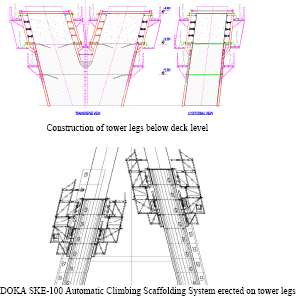 Construction of tower legs below deck level DOKA SKE-100 Automatic Climbing Scaffolding System erected on tower legs Construction of tower legs below deck level DOKA SKE-100 Automatic Climbing Scaffolding System erected on tower legs
a. Survey of Tower Legs
The complex pylon geometry was another challenge for surveyors. Coupled with geometry, the construction stage analysis indicated leaning and progressively increasing inward inclination of pylon legs during construction. HCC’s Principal Surveyor devised a sophisticated technology to measure coordinates through a combination of total station and prisms mounted on pylon legs. The temperature and construction stage analysis factors were applied to derive the corrected coordinates. The pylon legs were constructed within an accuracy of ±5mm, which speaks volumes about the technique employed.]
b. Anchorage Box
Anchorage Box for Bandra Cable Stay Bridge placed on Tower Head Junction Anchorage Box for Worli Cable Stay Bridge Anchorage Box is used as inner shuttering for tower head. Bearing plates with guide pipes are fixed to the anchorage box. Guide Pipe and Bearing Plates actually transfer the deck loads to tower concrete which are generated due to stressing of stay cables. The anchorage box is fabricated with 12mm thick high grade steel plates. It is fabricated in pieces and then bolted at tower head portion. The bearing plates and guide pipes of anchorage box are galvanized and the remaining portion was painted with anticorrosive polyurethane based paint.
Anchorage boxes are fixed with the help of co-ordinate system for accurately fixing the anchorage point and angle of stay cable. 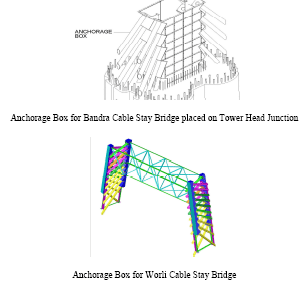 c. Compression struts c. Compression struts
Compression struts are provided at various levels of tower legs. These were basically provided to keep the alignment of all tower legs in their required position. During construction, due to geometry it was possible that the tower legs might lean inwards due to weight and stresses involved in the base. In order to avoid that, compression struts were
provided and jacking done to desired load to maintain the alignment.
d. Erection of Pier Table segments The pier table segments numbering 42 for both the carriageways were another hurdle encountered. The reasons being –
(a) Launching Truss could not be deployed;
(b) Being generally over the pylon pile cap, lifting segments from the sea was not possible. To overcome this hurdle, HCC’s Expat devised a brilliant and ingenious solution in the form of –
-Pier Table Trusses (PTT): One each was erected for each carriageway. It had rails on top to move segments with the help of hydraulic jacks from one end to another.
-Lifting Frame: This was an ingenious little devise mounted at either end of PTT.
SLU (Strand Lifting Units) were mounted on top to lift the segment from barges anchored in the sea. After lifting the segment, the front frame closed down, where the segment was lowered on the rails. The rear frame lifted up to enable the segment to slide across the PTT hydraulically.
STAGE: 1
Open the Support Bracket and Lift the Segment. Close the Support Bracket, Slide in the Trolley and Lower the Segment on Sliding Trolley
STAGE: 2
Opening of the Lifting Boom & Strut, Slide out the Segment and Close the Lifting Boom and & Strut. Repeat operations for the other segment lifting.
e. Erection of segments of Cable Stay Bridge by Derrick The method used for erection of segments at Cable-Stayed bridge was balance cantilever construction method. During construction, the length of free cantilever for Bandra Cable-
Stayed bridge was 215m and for Worli Cable-Stayed bridge it was 73m. The segments were lifted by the instrument named Derrick which was fixed on both ends of the pier table segment and then forwarded. Lifting operation was done simultaneously on both ends. At a time, Derrick can lift one segment. Deck is constructed of alternate stay and
non stay segments joined to pier table segments.
Lifting of Segment with Derrick
f. Dry Matching, Epoxy and temporary stressing for gluing When the segment is positioned, it is to be joined with the existing segment. Therefore, the segment was first dry-matched with the already erected segment. On completion of drymatching, the segment was moved back by sliding the lifting beam for a distance of 400mm of the derrick and epoxy was applied on the face of both segments. After application of the glue, the segments were joined together and were stressed by Temporary PT bars. Post this step, the segment lifting beam on derrick is moved forward to lift the next segment i.e. stay segment.
g. Erection of Stay segment
These segments were also erected similarly as the non-stay segment and were also joined in the similar way. After this, guide pipes were installed over the ducts left behind during segment casting.
h. Stay cable
Stay Cables used are ‘Parallel Wire Stay Cables’. They were manufactured by “Shanghai Pujiang Cable Co. Ltd” China. Each cable consists of a group of different number of steel wires. Each wire is made up of high tensile steel. Diameter of single wire was 7mm with a
breaking limit of 6.28 Tones. Six different sizes of cables were used in the cable-stayed portion. The difference between them was only on the basis of number of steel wires in each cable. Six different types used were of 61, 73, 85, 91, 109 and 121 steel wires. Group of these wires was packed in two layers of HDPE (High Density Poly Ethylene) material to protect them from atmospheric effects. Typical Cross Section of Stay Cable i. Closure pour
In Bandra Cable-Stayed Bridge, closure pour is provided between main cable-stayed cantilevers and back span. In Worli Cable-Stayed bridge, closure pour is provided between two cable-stayed cantilever decks
j. Longitudinal stressing and grouting
When all the segments and cables were erected, the segments were post tensioned longitudinally. This post tensioning was done by stressing the steel tendons placed in the ducts provided inside the body of segments. This helps the members to stay together and to increase their load carrying capacity as a large number of segments were joined together to make single unit. Once the stressing was done as per requirement, these holes or ducts were filled with cement grout and were plugged at both ends.
k. Fine tuning
After completion of closure pour and post-tensioning of the deck, fine tuning of stay cables is done. Fine tuning is fine force adjustments of the stay cables to achieve the required stresses in the deck and profile of the deck.
During fine tuning, forces in the stay cables are adjusted to suit further addition of superimposed dead loads such as wearing coat, crash barriers, handrails and also vehicle loads.
During fine tuning operation, longitudinal and transverse deck profiles are also monitored to provide smooth curve.
l. Wearing Coat over south bound bridge deck Bridge deck surface of south bound carriageway is provided with 40mm thick Polymer Modified Bituminous pavement in conjunction with water-proofing system to seal the bridge deck. Working during monsoon The Maritime Board does not allow marine traffic in monsoon season. Thus, work was halted mid-May only to re-commence in October, effectively reducing the work schedule to only seven months in a year. To overcome this hurdle and to use this time to speed up the construction activities at Bandra Pylon, HCC put forth the solution in the form of an innovatively designed temporary bridge. This bridge had a total length of 325 metres. It had the facility of a walkway, a concrete pipe line, an electrically-operated trolley mounted on rail, water line and a pipe line. It paved the way for successful continuation of work during the monsoon season when the sea was rough and the winds were strong. Logistics Another challenge was ensuring effective supply chain at all working locations spread across the alignment in the sea and formulating measures to ensure the same. A diligently worked out logistic plan was put into action to ensure that commodities were handled at dedicated
location and dispatches monitored meticulously. State-of-the-art electronic devices were placed on the barges to cut down on idle timings.
During peak construction activities, innovative procedures and specialized equipments were required to enable high accuracy. Expert crews had to also exercise good judgement in assessing sea behavior and priorities during foundation/ substructure constructions and final
placement of concrete in situ. Navigation and transporting 19 precast segments in 24 hours at different open sea locations was a challenge. Secondly, concrete consumption at the peak had been at the rate of 50cum/hr. Under marine conditions, the consumption rate has been in the order of 700cum per day. To add to this, maintaining adequate food supply for around 2500 people (in a shift) working in the sea at over 30 locations was a big challenge. These complete requirements were met with an effective utilization of a fleet of 30 marine vessels
including 13 barges for concrete, segments and material transport, eight steel boats for material and workers transport, three tug boats and six smaller passenger boats.
Around four passenger boats were used for carrying food to approximately 30 locations in the sea. Each employee, while starting his day, entered the log indicating the location at which they would be working. Thereafter began the clockwork of gathering tiffin boxes, washing and cleaning, allocation and dispatch as per the log entries along with the drinking water supply including tea supply at two time intervals per shift. During rough sea conditions in the normal working season, extra tiffins were carried to take care of possible spillage while
transferring the tiffins from boats to working locations. Thus workers were also suitably cared for, while meeting the engineering challenges posed during construction of the Bandra- Worli Sea Link. Psychological conditioning With a long track record and experienced in building large infrastructure projects, HCC follows strict guidelines for occupational health and safety and environment protection.
Safety is extremely important to HCC and the company officials worked towards sensitising labour and creating greater awareness of safety standards with gentle persuasion, consistent motivation and tool box meetings. The kind of structured processes that were implemented by HCC for ensuring safety is nothing short of phenomenal.
Lack of awareness is the biggest hazard for safety. Since the primary safety hazard are related to engineering control, equipment, job methodology, material handling, structural fabrication and emergency preparedness, HCC made sure that every worker is taken through the HSE program. The orientation program made them aware of the various safety hazards associated with a project and necessary precautions to be taken to prevent them. They are also taught how to evacuate during any emergency. For its meticulous planning and implementation of safety practices for the BWSL project, HCC has won the prestigious “Golden Peacock Award” for safety, health and environment in June 2007. Key people Over 3000 workers were employed to work on the project. Several teams of HCC engineers and foreign engineers and technicians have been involved in specialised tasks on the structure of the Sea Link. These include professionals from China, Egypt, Canada, Switzerland,
Britain, Serbia, Australia, Singapore, Thailand, Hong Kong, Indonesia and the Philippines. In terms of language, cultural differences and methods of work these key people were different, yet the engineering challenges kept the group creatively involved, and they worked enthusiastically as a team. |

 Superstructure The BWSL Project has (9+2) approach bridge modules. These modules range from 3 continuous span units to 8 continuous span units. The deck of the carriageways consists of triple cell precast box girders supported on piers founded on independent substructure. The Concrete Grade for the superstructure is M60. The average weight of the span is 1800 tons, whereas the heaviest span in the bridge (to be erected with the Launching Gantry) weighs 2000 tons. In addition, the trusses were to be designed to receive the segment from the already erected deck as well as from barges parked directly under the truss.
Superstructure The BWSL Project has (9+2) approach bridge modules. These modules range from 3 continuous span units to 8 continuous span units. The deck of the carriageways consists of triple cell precast box girders supported on piers founded on independent substructure. The Concrete Grade for the superstructure is M60. The average weight of the span is 1800 tons, whereas the heaviest span in the bridge (to be erected with the Launching Gantry) weighs 2000 tons. In addition, the trusses were to be designed to receive the segment from the already erected deck as well as from barges parked directly under the truss. Relocation of Launching Trusses using 1600MT capacity Barge Mounted Crane – Asian Hercules After the successful erection of the deck on Bandra side, the trusses were required to be shifted across the Bandra cable stay bridge by 600 meters to Worli side to take up the spans
Relocation of Launching Trusses using 1600MT capacity Barge Mounted Crane – Asian Hercules After the successful erection of the deck on Bandra side, the trusses were required to be shifted across the Bandra cable stay bridge by 600 meters to Worli side to take up the spans Coupled with the fact that the aesthetically designed pylons have an extremely complex geometry and one of the longest spans for concrete deck, the challenges encountered were indeed formidable.
Coupled with the fact that the aesthetically designed pylons have an extremely complex geometry and one of the longest spans for concrete deck, the challenges encountered were indeed formidable.

 Construction of tower legs below deck level DOKA SKE-100 Automatic Climbing Scaffolding System erected on tower legs
Construction of tower legs below deck level DOKA SKE-100 Automatic Climbing Scaffolding System erected on tower legs c. Compression struts
c. Compression struts










 (25 votes, average: 2.20 out of 5)
(25 votes, average: 2.20 out of 5)
Hi
I think this project is a part of the Western Freeway Sea Project, which, in turn, is a part of a larger proposal to upgrade the road transportation network of greater Mumbai.
GPS could play a great role in construction control.
Leave your response!
MY NEWS
Maxar and Saab form strategic partnership for multi-domain battlespace and European space capabilities RIEGL celebrates grand opening of new hangar in Krems BlackSky and Rocket Lab set launch window for second Gen-3 satellite GeoTerra selects Vexcel’s UltraCam Merlin 4.1 In Memory of Professor Ferjan Ormeling (1942–2025) Mentor, Scholar, and Cartographer with Boundless Imagination
More...Order your FREE copy!
PREVIEW THE BOOK
PREVIEW THE BOOK
________________________________________
The Drone Rules in India 2021
________________________________________
National Geospatial Policy of India 2022
________________________________________
Indian Satellite Navigation Policy – 2021 (Draft)
________________________________________
Guidelines for acquiring and producing Geospatial Data and Geospatial Data Services including Maps
________________________________________
Draft Space Based Remote Sensing Policy of India – 2020
________________________________________
National Unmanned Aircraft System (UAS) Traffic Management Policy – Draft
________________________________________
Advertisement
Interview
Kiyokazu Minami
Secretary General, Executive Director, Japan Institute of Navigation
Member, Leader of GPS/GNSS research group, Japan Institute of Navigation
Easy Subscribe
Previous Issues
- Vol. XXI, Issue 5, May 2025
- Vol. XXI, Issue 4, April 2025
- Vol. XXI, Issue 3, March 2025
- Vol. XXI, Issue 2, February 2025
- Vol. XXI, Issue 1, January 2025
- Vol. XX, Issue 12, December 2024
- Vol. XX, Issue 11, November 2024
- Vol. XX, Issue 10, October 2024
- Vol. XX, Issue 9, September 2024
- Vol. XX, Issue 8, August 2024
- Vol. XX, Issue 7, July 2024
- Vol. XX, Issue 6, June 2024
- Vol. XX, Issue 5, May 2024
- Vol. XX, Issue 4, April 2024
- Vol. XX, Issue 3, March 2024
View AllLog In
E-ZINE
- April 2025
- March 2025
- February 2025
- January 2025
- December 2024
- November 2024
- October 2024
- September 2024
- August 2024
- July 2024
- June 2024
- May 2024
View AllPartnership
November 1-2, 2023
Maryland, USA
6-8 November
Calgary, Canada
8 - 10 November
Gyeonggi Province
Republic of Korea.
11-13, February
Denver, The USA
14 - 15 February 2024
Dubai, UAE
6-7 March, 2024
Singapore
11-13 March
London, U.K.
29 - 30 April
Kuala Lumpur, Malaysia
2-4 May 2024
Angers, France
14-15 May 2024
Ottawa, Canada
05 - 06 June
London, UK
16-20 September
Baltimore, USA
24-26 September 2024
Kuching, Malaysia
24-26, September
Stuttgart, Germany
11-13, November
Las Vegas, USA
4-7 October
Hyderabad India
6-8 November 2024
Goyang city, South Korea
26 – 28 November 2024
Dubai, UAE
10 -12 December 2024
Universiti Putra Malayasia (UPM), Malaysia
10 - 12 February, 2025
The Queen Elizabeth II Centre, London
1-3 April
Porto, Portugal
9-10 April 2025
Singapore
23-24 April 2025
Washington DC, USA
5 - 6 May 2025
Jeddah, Saudi Arabia.
12-14, May
Ottawa, Canada
21-23, May 2025
Wrocław, Poland
4 - 5 June
London, UK
8-12 September
Baltimore, USA
21 - 24 September 2025
Baška, Krk Island, Croatia
3-5,November
Calgary, Canada
3-5 November 2025
Florianópolis, Santa Catarina, Brazil
View Past Events